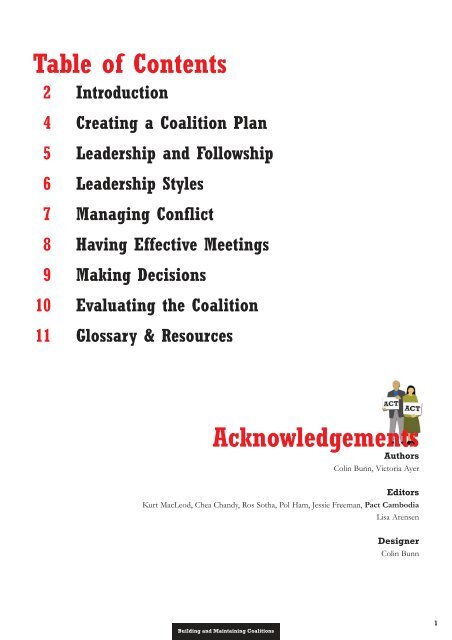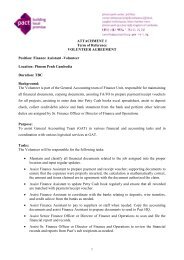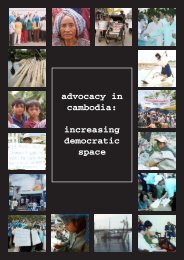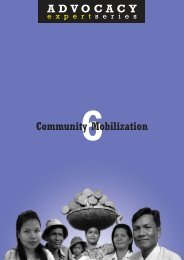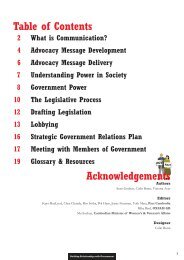Advocacy - Module 4 - English.pdf - Pact Cambodia
Advocacy - Module 4 - English.pdf - Pact Cambodia
Advocacy - Module 4 - English.pdf - Pact Cambodia
You also want an ePaper? Increase the reach of your titles
YUMPU automatically turns print PDFs into web optimized ePapers that Google loves.
Table of Contents<br />
2 Introduction<br />
4 Creating a Coalition Plan<br />
5 Leadership and Followship<br />
6 Leadership Styles<br />
7 Managing Conflict<br />
8 Having Effective Meetings<br />
9 Making Decisions<br />
10 Evaluating the Coalition<br />
11 Glossary & Resources<br />
Acknowledgements<br />
Authors<br />
Colin Bunn, Victoria Ayer<br />
Editors<br />
Kurt MacLeod, Chea Chandy, Ros Sotha, Pol Ham, Jessie Freeman, <strong>Pact</strong> <strong>Cambodia</strong><br />
Lisa Arensen<br />
Designer<br />
Colin Bunn<br />
Building and Maintaining Coalitions<br />
1
Introduction<br />
A coalition is a group of people or organizations working together to pursue a single goal. In<br />
coalitions, all members make a long-term commitment to share responsibilities and resources.<br />
Whenever possible, our organization should seek to build or join a coalition to strengthen the<br />
impact of our advocacy. The purpose of this book, the fourth in our <strong>Advocacy</strong> Expert Series,<br />
is to explore methods of creating and sustaining coalitions that will assist us in advancing the<br />
goals of our advocacy campaign.<br />
Why should our NGO form a Coalition?<br />
Coalitions allow us to share information, ideas, and resources with other<br />
organizations as well as distribute the risks and responsibilities of our<br />
advocacy campaign among members. In addition, coalitions offer us:<br />
• Safety<br />
• Increased access to decision makers and other contacts<br />
• Improved credibility and visibility<br />
• An opportunity to broaden public support<br />
• A chance to strengthen civil society<br />
What is a Coalition?<br />
Coalitions are groups of people or organizations<br />
working together to pursue a single<br />
goal. In coalitions, all members make a longterm<br />
commitment to share responsibilities<br />
and resources.<br />
What is an Alliance?<br />
Alliances are based on short-term relationships<br />
between people or organizations to<br />
achieve narrowly focused objectives. Limits<br />
on time and responsibilities make alliances<br />
less demanding than coalitions on their<br />
members.<br />
What is a Network?<br />
Networks are people or organizations with<br />
Different NGOs have different areas expertise, different resources, and similar interests or concerns who share information<br />
and ideas. Each person or organiza-<br />
attract different stakeholders. Building a diverse coalition with a variety<br />
tion remains independent.<br />
of NGOs will increase our chances for success and prove to decision<br />
makers that there is broad social support for our desired policy change. Decision makers are also more likely to pay<br />
attention to coalitions–a coalition of several NGOs working together can advocate more effectively than one.<br />
Creating a Successful Coalition<br />
Successful coalitions are built on trust, respect, and a commitment to working together. In order for a coalition to remain<br />
strong, participating organizations must respect each other and the decisions made by the coalition leadership. All successful<br />
coalitions share:<br />
1<br />
Diverse<br />
2 3<br />
Clear coalition membership<br />
structure and broad<br />
outreach<br />
4 5<br />
leadership<br />
Skilled and<br />
diverse<br />
Reliable<br />
system of<br />
communication<br />
and conflict<br />
resolution<br />
Trusting<br />
relationships<br />
among<br />
members<br />
There are two ways of getting involved in a<br />
coalition: Join one or build one ourselves.<br />
Before building a new coalition to advance<br />
our advocacy campaign, check to see if one<br />
already exists.<br />
2<br />
Building and Maintaining Coalitions
1<br />
Clear coalition<br />
structure<br />
A coalition requires more time, energy, and commitment from members than a network or alliance. Sometimes members<br />
must sacrifice their own interests to promote the interests of the coalition. One of the most important first steps<br />
in building a coalition is creating a clear structure. A clear structure helps members understand how the coalition will<br />
work, minimizes conflicts, and establishes order. When forming our coalition here are some things to consider:<br />
COALITION CHECKLIST<br />
MEMBERSHIP Which other organizations do we want to<br />
work with? What are the criteria for joining our coalition?<br />
A large, diverse group of participating organizations will expand our<br />
coalition's knowledge, skills, and resources but may be difficult to manage.<br />
A small group will be easier to manage but may not have the same<br />
level of impact or influence. In both situations, our coalition should have a<br />
clear statement of principles that defines our purpose, mission, goals, and<br />
benefits of membership.<br />
<strong>Advocacy</strong> in<br />
CAMBODIA<br />
The Gender Project is a coalition of<br />
organizations created by NGO Forum<br />
to address important gender-related<br />
issues in <strong>Cambodia</strong>. Over the course<br />
of their advocacy work, the coalition<br />
helped local government officials<br />
improve their ability to resolve gender<br />
related conflicts as well as<br />
encourage political parties to share<br />
their gender policies with the public.<br />
COMMITMENT What expectations do we have of coalition<br />
members? Where, when, and how often does the coalition meet?<br />
Our coalition must meet frequently enough to keep all members informed, involved, and motivated. The coalition must<br />
also create reasonable expectations of work and responsibilities among members. In addition to a statement of principles,<br />
our coalition should have written policies regarding behavior and obligations of members that are consistent and<br />
fair. All members should respect these policies and participate to the best of their ability.<br />
DECISION MAKING How will the decision making process work?<br />
The coalition's decision making process must be built on the principles of equality and democracy. This must include<br />
opportunities for group discussion, procedures for conflict resolution, methods for delegating tasks, and a scheduled<br />
rotation of leadership responsibilities.<br />
COMMUNICATION How will members communicate with each other?<br />
We must establish a system of communication that allows members to exchange information and ideas quickly and efficiently.<br />
All members must commit to attending regular meetings and events. Records of all meeting agendas, minutes,<br />
decisions made and actions taken should be organized and available to members. The coalition should also select a<br />
spokesperson and create a communication plan for crisis situations.<br />
Building and Maintaining Coalitions<br />
3
Diverse<br />
2<br />
membership<br />
and broad<br />
outreach<br />
Creating a Coalition Plan<br />
Once we have completed our coalition checklist, we can prepare a Coalition Plan. This plan will list our coalition’s advocacy<br />
goal and all of the members of our coalition, their areas of expertise, resources, and responsibilities.<br />
SAMPLE COALITION PLAN<br />
Goal: Adoption and implementation of a Domestic Violence Law within 5 years.<br />
NAME OF MEMBER<br />
REPRESENTATIVE(S)<br />
NAME, TITLE, AND<br />
CONTACT<br />
AREA OF<br />
EXPERTISE<br />
RESOURCES<br />
PRIMARY<br />
RESPONSIBILITY<br />
The <strong>Cambodia</strong>n<br />
Committee of Women<br />
(CAMBOW)<br />
Seng Sophal,<br />
Program Director<br />
Women’s rights’<br />
Network of<br />
women’s rights’ NGOs<br />
Research and statistics<br />
Fulltime staff<br />
Funding<br />
Monitoring<br />
and evaluation<br />
Draft and review law<br />
Lobby Ministry of<br />
Women’s Affairs<br />
Create Government<br />
Relations Plan<br />
Women’s Media<br />
Center<br />
Mrs. Sue Franklin,<br />
Country<br />
Representative<br />
Media<br />
TV and radio<br />
production facilities<br />
Expertise and contacts<br />
with media<br />
Produce and<br />
broadcast<br />
TV and Radio spots<br />
Create Media plan<br />
Develop media<br />
messages<br />
Lobby Ministry of<br />
Health<br />
<strong>Cambodia</strong> Association<br />
of Doctors<br />
& Medical Schools<br />
Dr. Heng Sam Ath,<br />
CAD Director<br />
Health<br />
Medical expertise<br />
for lobbying<br />
Care provider<br />
Conduct Domestic<br />
Violence classes at<br />
schools<br />
Provide expert<br />
witnesses at trial<br />
Fundraising at games<br />
Phnom Penh football<br />
league<br />
Coach Heap Makgal<br />
Sports<br />
Volunteers<br />
Different target<br />
audience<br />
Public appearances to<br />
support campaign<br />
Education of football<br />
players<br />
Good coalitions look beyond natural allies<br />
and typical supporters to find new partners.<br />
Despite our best efforts to make our coalition diverse and balanced, we<br />
may forget to include members with specific skills and resources relevant<br />
to our advocacy campaign. Developing a coalition plan will help us<br />
address these weaknesses early in our coalition building process.<br />
4<br />
Building and Maintaining Coalitions
Skilled 3and<br />
diverse<br />
leadership<br />
Leadership and Followship<br />
With all of skills, time, and resources needed to reach our advocacy goal, it would be impossible for one person to succeed<br />
working alone. Our coalition needs leaders and followers.<br />
LEADERS<br />
Leaders are equally concerned with completing<br />
tasks and motivating people. Leaders<br />
respond to the changing needs and priorities<br />
of their organization. Good leaders change<br />
their leadership style depending on personalities<br />
and circumstances. Good leaders are<br />
also good followers.<br />
FOLLOWERS<br />
Followers must understand the priorities of<br />
the coalition but remain flexible enough to<br />
adapt to changing needs. Followers should<br />
also have a high level personal integrity,<br />
respect for the leaders, and be comfortable<br />
taking responsibility for their own actions.<br />
Leaders and Followers are Active Listeners<br />
Good leaders and followers are also excellent listeners. They respect the<br />
ideas and opinions of others even when they do not agree. Most importantly,<br />
leaders and followers are comfortable giving and receiving feedback.<br />
ACTIVE LISTENING LOOP<br />
No matter what our job title, we are followers<br />
more often than we are leaders.We are<br />
always accountable to others: supervisors,<br />
donors, stakeholders, or the public.<br />
Leader communicates idea.<br />
Follower receives idea from leader.<br />
LEADER<br />
FOLLOWER<br />
Leader receives feedback from follower.<br />
Follower communicates feedback.<br />
A good leader creates an environment where everyone, both leaders and followers,<br />
enjoys working, problem-solving, and accomplishing goals<br />
together.<br />
Building and Maintaining Coalitions<br />
5
Leadership Styles<br />
Skilled 3and<br />
diverse<br />
leadership<br />
Leaders consider the skills and experience of followers and use the following four leadership styles to help accomplish<br />
tasks.<br />
DIRECT COACH SUPPORT DELEGATE<br />
A direct leadership style<br />
works best when:<br />
• The task must be completed<br />
quickly and only<br />
the leader knows what<br />
needs to be done and<br />
how to do it.<br />
• Followers lack experience<br />
or expertise.<br />
EXAMPLE:<br />
A new employee with no<br />
experience should not be<br />
given a task to do without<br />
direction, training and<br />
supervision.<br />
DIRECT COACH SUPPORT DELEGATE<br />
A coach encourages followers<br />
to think for themselves<br />
but still maintains overall<br />
control. This leadership<br />
style works best when:<br />
• Followers have excelled<br />
under a direct leadership<br />
style.<br />
• Followers are eager to<br />
work independently but<br />
still require periodic<br />
supervision.<br />
EXAMPLE:<br />
Some people need coaching<br />
from leaders or more<br />
experienced colleagues<br />
before they feel comfortable<br />
working independently.<br />
6<br />
Building and Maintaining Coalitions
Skilled 3and<br />
diverse<br />
leadership<br />
DIRECT COACH SUPPORT DELEGATE<br />
When leaders support<br />
independent actions and<br />
problem solving, followers<br />
gain confidence and experience.<br />
This leadership<br />
works best when:<br />
• Followers have demonstrated<br />
their competence<br />
and expertise in the past.<br />
• Followers are comfortable<br />
thinking for themselves.<br />
EXAMPLE:<br />
An NGO employee managing<br />
a provincial office<br />
makes decisions independently<br />
but needs long-term<br />
support and guidance from<br />
the NGO headquarters to<br />
be successful.<br />
DIRECT COACH SUPPORT DELEGATE<br />
By distributing problemsolving<br />
and decision-making<br />
authority to followers,<br />
leaders are helping followers<br />
become leaders themselves.<br />
This leadership style<br />
works best when:<br />
• Followers are mature,<br />
experienced, and motivated<br />
to perform the delegated<br />
task.<br />
• Followers are able to analyze<br />
a problem, determine<br />
what needs to be<br />
done, and execute the<br />
task.<br />
EXAMPLE:<br />
The president of a large<br />
company does not have the<br />
time to run the company<br />
alone. They must delegate<br />
work and responsibilities to<br />
experienced staff and managers.<br />
Building and Maintaining Coalitions<br />
7
Reliable<br />
system<br />
4<br />
of<br />
communication<br />
and conflict<br />
resolution<br />
Managing Conflict<br />
Conflict is natural and unavoidable. People’s unique experiences lead to differing opinions and perspectives. Due to their<br />
size and complexity, coalitions often have difficulty managing conflict. They sometimes suffer from unrealistic expectations<br />
such as the idea that members who share a common cause will agree on everything. Successful coalitions plan for<br />
conflict and understand when to work through differences and when to agree to disagree. There are four steps to effectively<br />
managing conflict in a coalition:<br />
1<br />
Identify the problem<br />
When we encounter conflict in our coalition, we must first determine<br />
its root causes. If the conflict is not being expressed directly, we<br />
need to create opportunities to discuss the issue openly. Failure to identify<br />
the problem thoroughly can lead to further conflict and ultimately<br />
damage our coalition.<br />
Coalitions often fail because a member feels<br />
insulted, ignored, or unappreciated. Rotate<br />
leadership responsibilities to create a<br />
sense of ownership among members. Share<br />
credit for successes equally.<br />
2<br />
Discover mutual interests<br />
In many cases, conflict occurs when individual coalition members believe that their concerns are not heard or<br />
respected. We need to ensure that all coalition members, regardless of their size, power, contributions, or authority are<br />
given equal opportunity to express themselves. Despite contradictory positions on various issues, members may be surprised<br />
to discover mutual interests that can help generate mutual goals and options for resolving conflict.<br />
3<br />
Generate Options<br />
After identifying areas of mutual interest, we can generate options for resolving the conflict. Some members may<br />
feel strongly about their position on the issue and demand that the coalition take their recommended action. Others may<br />
disagree with the proposed solution but do not feel strongly enough to oppose it. Exploring all of the possible solutions<br />
to a problem may take time.<br />
4<br />
Build Consensus<br />
Building consensus means creating agreement between coalition members. It is achieved through actively listening,<br />
working through differences, finding areas of compromise, and convincing individual members that this solution is<br />
in the best interest of the coalition.<br />
Interests<br />
Our interests are our hopes, needs,<br />
fears, and concerns.<br />
Position<br />
Our position is our preferred solution<br />
to a problem<br />
fears<br />
hope<br />
concerns<br />
Our position<br />
needs<br />
8<br />
Building and Maintaining Coalitions
Reliable<br />
system<br />
4<br />
of<br />
communication<br />
and conflict<br />
resolution<br />
Having Effective Meetings<br />
Hosting regular meetings is one of the best ways to keep coalition members informed, involved, and inspired. It is during<br />
meetings where issues are discussed and decisions made. All effective meetings have a chairperson,a minute taker,<br />
and an agenda. To help us make difficult or complex decisions, we can use the skills of a facilitator.<br />
CHAIRPERSON<br />
The chairperson is the person in charge of the meeting. They ensure that all participants respect the rules of meeting<br />
and follow the agenda. As the leader of the meeting, the chairperson should model the principles of active listening by<br />
respecting the contributions of all members.<br />
The minute taker records attendance, topics discussed, and decisions<br />
made during a meeting. Successful meetings always begin with a review<br />
and approval of the minutes from the previous meeting.<br />
An agenda is a schedule for the meeting that states the main topics to<br />
be discussed. The agenda should be distributed to all members before<br />
the meeting and include the following:<br />
• Meeting start and end time.<br />
• Meeting location.<br />
• Topic headings (no more than 5) with a short paragraph about<br />
each.<br />
• Set a time limit for each agenda item. Respect it!<br />
• Indicate which participants are expected to lead discuss about each<br />
topic.<br />
Facilitators act as impartial mediators to<br />
help us build consensus. Facilitators also<br />
help us:<br />
• Define the decision that needs to be made<br />
• Guide the coalition through the stages of<br />
reaching an agreement<br />
• Focus discussion and draw conclusions<br />
• Ensure that everyone has a chance to<br />
express themselves<br />
MINUTE TAKER<br />
AGENDA<br />
MINUTES<br />
Working Group on Freedom of Infor<br />
Thursday, February 26, 2004 at A<br />
Chairperson: Mr. Ros Sotha, APP/<strong>Pact</strong><br />
Minute taker: Ms. Katarina Hammarberg, Advisor ADHOC<br />
Participants: Mr. Kurt MacLeod, <strong>Pact</strong>, Mr. Thun Saray, ADHOC, Mr.<br />
Kampuchea, Mr. Hou Puthvisat, Rasmei Kampuchea, Ms. Victoria Aye<br />
Hammarbrg, ADHOC, Mr. Pok Leaksmy, Moneaksekur Khmer, Mr. U<br />
HCHR, Mr. Ros Sotha, <strong>Pact</strong>, Mr. Lay Sovathara, CLEC, Mr. Sek Sopho<br />
AGENDA OF THE MEETING<br />
- Introduction<br />
- Approval of agenda<br />
- Approval of the last minutes<br />
- Reports of the sub-working groups<br />
- Next activities<br />
- New members of the working group<br />
- Distribution and introduction of the public rights to kn<br />
Introduction<br />
Mr. Thun Saray, President of ADHOC, gave a presentation of the b<br />
the working group on FOIA in <strong>Cambodia</strong>. All institutions should b<br />
threat to national security etc. Contracts between the government a<br />
there is no mechanism to punish an institution or person that does<br />
cy, and the NGOs have lacked human resources to do research on<br />
HCHR resulted in the formation of this working group. The hope<br />
working group: government, party representatives, media, private s<br />
Mr. Thun Saray informed that ADHOC has been in contact with<br />
suggested that there is a referral to FOIA in the anti-corruption la<br />
speed up the process to pass a law on FOI. Even though there is<br />
government.<br />
The agenda and the last minutes<br />
The agenda of the day and the last minutes were approved.<br />
Review of activities<br />
The following activities have been undertaken since the last mee<br />
1.The translation of Article 19 into Khmer is completed.<br />
Building and Maintaining Coalitions<br />
9
Trusting<br />
relationships<br />
5<br />
among<br />
members<br />
Making Decisions<br />
Making decisions as a group is one of the most important skills of<br />
working in a coalition. If members of your coalition feel ignored during<br />
the decision making process they are less likely stay involved and motivated.<br />
Any decision making method should encourage participation and<br />
equality.<br />
The two major types of decision making processes are voting and consensus.<br />
MEETING<br />
CHECKLIST<br />
Here are some tips to keep in mind for our<br />
next coalition meeting:<br />
Before the Meeting<br />
Select Chairperson.<br />
Select appropriate location and time<br />
for meeting.<br />
VOTING<br />
Members create and choose<br />
from a list of priorities. The priority<br />
with the most votes will<br />
be implemented.<br />
CONSENSUS<br />
Members work together to reach<br />
an unanimous agreement.<br />
Prepare agenda and minutes from<br />
previous meeting and distribute to all<br />
members.<br />
Invite all members and follow up to<br />
confirm attendance.<br />
During the Meeting<br />
Start on time and end early.<br />
Follow the agenda.<br />
Encourage group discussion but keep<br />
the conversation focused on the topic.<br />
Keep minutes of the meeting for future<br />
reference and record keeping.<br />
Though consensus may take more time than voting, a decision that<br />
every member supports will be easier to implement. We can create consensus<br />
by actively listening to the ideas and opinions of our coalition<br />
members and integrating their thoughts into a decision that is acceptable<br />
to everyone.<br />
Creating Priorities<br />
Creating priorities means weighing the advantages, disadvantages, and<br />
potential consequences of each proposed solution to a problem. The<br />
solutions with the fewest disadvantages and most favorable consequences<br />
are the ones our coalition should implement.<br />
Be a role model by listening, showing<br />
interest, appreciation and confidence<br />
in members. Admit mistakes.<br />
Summarize agreements reached and<br />
end the meeting on a unifying or positive<br />
note.<br />
Put unfinished business on the agenda<br />
for the next meeting.<br />
After the Meeting<br />
Write up and distribute minutes within<br />
3 days.<br />
Follow-up on decisions made during<br />
the meeting. Ensure that all members<br />
understand and carry-out their responsibilities.<br />
Give recognition and appreciation to<br />
excellent and timely progress.<br />
10<br />
Building and Maintaining Coalitions
Evaluating the Coalition<br />
Over time, coalitions change in response to members’ shifting priorities or political conditions. Every six months, we<br />
should evaluate our coalition and decide what changes are needed to keep the coalition healthy and effective. Here are<br />
some sample questions to ask the coalition during our evaluation:<br />
What is the most difficult part of maintaining the coalition?<br />
What are the benefits of joining the coalition?<br />
What can we do differently?<br />
What are the most and least successful methods of<br />
communicating with the media, the public, government<br />
decision makers, beneficiaries, and other coalition<br />
members?<br />
How is our coalition bringing attention to the issue and<br />
building support for our advocacy goal?<br />
<strong>Advocacy</strong> in<br />
CAMBODIA<br />
In May 2004, the eighteen member coalition<br />
COSECAM (Coalition to Address<br />
Sexual Exploitation of Children in<br />
<strong>Cambodia</strong>) organized an eight-day tour<br />
throughout <strong>Cambodia</strong> to draw attention to<br />
the exploitation of children. Activities<br />
included theater acts, seminars, parades,<br />
workshops, and panel discussions.<br />
PHOTO: Cosecam buses travel to Sisophon<br />
on National Road 5.<br />
Are there any unresolved conflicts in the coalition?<br />
How can any unresolved conflicts be addressed and resolved?<br />
Conclusion<br />
A well-organized, diverse coalition is an incredibly effective advocacy tool. Sharing information, ideas, and resources not<br />
only makes advocacy work easier but also improves the likelihood of success. Hopefully, the skills and techniques you<br />
have learned in this book will help you build and maintain healthy coalitions that will persuade people in power to implement<br />
our advocacy goals.<br />
In our next book, "<strong>Advocacy</strong> through Legal Services", we will learn about the legal system and explore various legal<br />
strategies that will help advance the goals of our advocacy campaign.<br />
Building and Maintaining Coalitions<br />
11
ADVOCATE<br />
Formal Statements<br />
Public Speeches<br />
Letters of opposition or support<br />
Declarations by organizations and institutions<br />
Signed public statements<br />
Declarations of indictment and intention<br />
Group or mass petitions<br />
Communications with a Wider Audience<br />
Slogans, caricatures, and symbols<br />
Banners, posters, and displayed communications<br />
Leaflets, pamphlets, and books<br />
Newspapers and journals<br />
Records, radio, and television<br />
Skywriting and earthwriting<br />
Group Representations<br />
Deputations<br />
Mock awards<br />
Group lobbying<br />
Picketing<br />
Mock elections<br />
Symbolic Public Acts<br />
Displays of flags and symbolic colors<br />
Wearing of symbols<br />
Prayer and worship<br />
Delivering symbolic objects<br />
Protest disrobings<br />
Destruction of own property<br />
Symbolic lights<br />
Displays of portraits<br />
Paint as protest<br />
New signs and names<br />
Symbolic sounds<br />
Symbolic reclamations<br />
Rude gestures<br />
Drama and Music<br />
Humorous skits and pranks<br />
Performances of plays and music<br />
Singing<br />
Processions<br />
Marches<br />
Parades<br />
Religious processions<br />
Pilgrimages<br />
Motorcades<br />
Honoring the Dead<br />
Political mourning<br />
Mock funerals<br />
Demonstrative funerals<br />
Homage at burial places<br />
Public Assemblies<br />
Assemblies of protest or support<br />
Protest meetings<br />
Camouflaged meetings of protest<br />
Teach-ins<br />
Withdrawal and Renunciation<br />
Walk-outs<br />
Silence<br />
Renouncing honors<br />
Turning one’s back<br />
SOCIAL NON-COOPERATION<br />
Noncooperation with Social Events, Customs,<br />
and Institutions<br />
Suspension of social and sports activities<br />
Boycott of social affairs<br />
Student strike<br />
Social disobedience<br />
Withdrawal from social institutions<br />
Withdrawal from the Social System<br />
Stay-at-home<br />
Total personal noncooperation<br />
Protest emigration (hijrat)<br />
ECONOMIC NON-COOPERATION: Economic<br />
Actions by Consumers<br />
Consumers’ boycott<br />
Non-consumption of boycotted goods<br />
Policy of austerity<br />
Rent withholding<br />
Refusal to rent<br />
National consumers boycott<br />
International consumers boycott<br />
Action by Workers and Producers<br />
Workmen’s boycott<br />
Producers’ boycott<br />
ECONOMIC NON-COOPERATION: The Strike<br />
Agricultural Strikes<br />
Peasant strike<br />
Farm Workers strike<br />
Strikes by Special Groups<br />
Tactics of advocates<br />
around the world<br />
Refusal of impressed labor<br />
Prisoners strike<br />
Craft strike<br />
Professional strike<br />
Ordinary Industrial Strikes<br />
Establishment strike<br />
Industry strike<br />
Sympathetic strike<br />
Restricted Strikes<br />
Detailed strike<br />
Bumper strike<br />
Slowdown strike<br />
Working-to-rule strike<br />
Reporting "sick" (sick-in)<br />
Strike by resignation<br />
Limited strike<br />
Selective strike<br />
Multi-Industry Strikes<br />
Generalized strike<br />
General strike<br />
Combination of Strikes and Economic Closures<br />
City Wide Strike<br />
Economic shutdown<br />
POLITICAL NON-COOPERATION<br />
Rejection of Authority<br />
Withholding or withdrawal of allegiance<br />
Refusal of public support<br />
Literature and speeches advocating resistance<br />
Boycott of government-supported organizations<br />
Refusal of assistance to enforcement agents<br />
Removal of own signs and placemarks<br />
Refusal to dissolve existing institutions<br />
Citizens’ Alternatives to Obedience<br />
Reluctant and slow compliance<br />
Non-obedience in absence of direct supervision<br />
Popular non-obedience<br />
Disguised disobedience<br />
Refusal of an assemblage or meeting to disperse<br />
Sitdown<br />
Noncooperation with conscription and deportation<br />
Hiding, escape, and false identities<br />
Civil disobedience of "illegitimate" laws<br />
International Governmental Action<br />
Changes in diplomatic and other representations<br />
Delay and cancellation of diplomatic events<br />
Withholding of diplomatic recognition<br />
Severance of diplomatic relations<br />
Withdrawal from international organizations<br />
Refusal of membership in international bodies<br />
Expulsion from international organizations<br />
NONVIOLENT INTERVENTION<br />
Psychological Intervention<br />
Self-exposure to the elements<br />
The Fast<br />
Reverse trial<br />
Nonviolent harassment<br />
Physical Intervention<br />
Sit-in<br />
Stand-in<br />
Ride-in<br />
Wade-in<br />
Pray-in<br />
Nonviolent obstruction<br />
Social Intervention<br />
Establishing new social patterns<br />
Speak-in<br />
Theater<br />
Alternative social institutions<br />
Alternative communication system<br />
Economic Intervention<br />
Reverse strike<br />
Stay-in strike<br />
Defiance of blockades<br />
Preclusive purchasing<br />
Dumping<br />
Alternative markets<br />
Alternative transportation systems<br />
Alternative economic institutions<br />
Political Intervention<br />
Overloading of administrative systems<br />
Disclosing identities of secret agents<br />
Seeking imprisonment<br />
Civil disobedience of "neutral" laws<br />
Dual sovereignty and parallel government<br />
Adapted from Gene Sharp, The Politics of Nonviolent<br />
Action, Vol. 2: The Methods of Nonviolent Action<br />
(Boston: Porter Sargent Publishers, 1973).<br />
Ostracism of Persons<br />
Social boycott<br />
Selective social boycott<br />
Citizens’ Noncooperation with Government<br />
Boycott of legislative bodies<br />
Boycott of elections<br />
Boycott of government employment and positions<br />
Boycott of government departments, agencies, and<br />
other bodies<br />
Withdrawal from government educational institutions<br />
12<br />
Building and Maintaining Coalitions
Glossary<br />
Autocratic<br />
A person with unlimited power or authority who makes<br />
decisions for everyone.<br />
Alliance<br />
An association of people, groups, organizations, or nations<br />
based on short-term relationships to achieve narrowly<br />
focused objectives.<br />
Consensus<br />
An opinion or decision reached by a group.<br />
Credibility<br />
The quality of being believable or trustworthy.<br />
Delegate<br />
To entrust or transfer power, authority, or responsibility to<br />
another person or group.<br />
Position<br />
A preferred solution to a problem<br />
Network<br />
A group of people or organizations with similar interests or<br />
concerns who share information and ideas.<br />
Resources<br />
For more information on these topics:<br />
<strong>Advocacy</strong> for Immunization:<br />
Global Alliance for Vaccines and Immunizations<br />
(2001)<br />
UNESCO/APC Multimedia Training Kit<br />
Search for Common Ground<br />
http://www.itrainonline.org/<br />
ACT UP: Civil Disobedience Training<br />
http://www.actupny.org<br />
Mind Tools<br />
http://www.mindtools.com<br />
Good Practice Participate<br />
Office for the Community & Voluntary Sector<br />
http://www.goodpracticeparticipate.govt.nz<br />
New Product Development Solutions<br />
http://www.npd-solutions.com<br />
<strong>Advocacy</strong> Tools and Guidelines: Promoting Policy<br />
Change<br />
Sofia Sprechman and Emily Pelton, CARE (2001)<br />
http://www.careusa.org/getinvolved/advocacy/tools.asp<br />
Building and Maintaining Coalitions<br />
13


